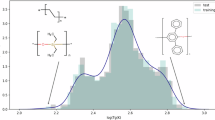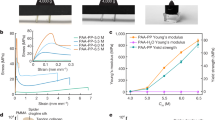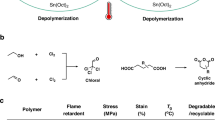Abstract
The glass transition is of primary relevance to the forming conditions and end-use properties of polymeric materials. Several polymers of industrial importance, most notably polyvinyl chloride (PVC), contain small molecules as processing lubricants (plasticizers) and are, therefore, solutions. Separately, economic and materials advantages have spurred the use of one-phase mixtures (miscible blends) of high polymers. The general theme of the compositional variation of glass-transition temperatures (Tg) includes, in addition, the variation of Tg with degree of polymerization, with cross-link density (network formation) and with copolymer composition. An attempt is made here to find a unified basis for the prediction of these several aspects of an identifiably single topic.
This is a preview of subscription content, access via your institution
Access options
Subscribe to this journal
Receive 51 print issues and online access
$199.00 per year
only $3.90 per issue
Buy this article
- Purchase on SpringerLink
- Instant access to full article PDF
Prices may be subject to local taxes which are calculated during checkout
Similar content being viewed by others
References
Couchman, P. R. Macromolecules 13, 1272–1276 (1980).
Leisz, D. M., Kleiner, L. W. & Gertenbach, P. G. Thermochim. Acta 35, 51–58 (1980).
Ryan, C. L. thesis, Univ. Massachusetts (1981).
Bair, H. E. & Warren, P. C. J. macromolec. Sci.-Phys. B20, 381–402 (1981).
Ellis, T., Karasz, F. E. & Moy, P. Polym. Preprints 22, 121–122 (1981).
Couchman, P. R. J. mater. Sci. 15, 1680–1683 (1980).
Martin, C. G., Mehta, R. K. & Lott, S. E. Polym. Preprints 22, 319–320 (1981).
Wall, F. T. J. Am. chem. Soc. 66, 2050–2057 (1944).
Comyn, J. & Fernandez, R. A. Eur. Polym. J. 11, 149–151 (1975).
Landau, L. & Lifschitz, E. M. Statistical Physics 2nd edn (Pergamon, Oxford, 1969).
Angell, C. A., Sare, J. M. & Sare, E. J. J. phys. Chem. 82, 2622–2629 (1978).
Author information
Authors and Affiliations
Rights and permissions
About this article
Cite this article
Couchman, P. Composition-dependent glass-transition temperatures and copolymers. Nature 298, 729–730 (1982). https://doi.org/10.1038/298729a0
Received:
Accepted:
Issue date:
DOI: https://doi.org/10.1038/298729a0
This article is cited by
-
Solid-State NMR Investigation of Drug-Excipient Interactions and Phase Behavior in Indomethacin-Eudragit E Amorphous Solid Dispersions
Pharmaceutical Research (2018)
-
Hydrogen-bonding in polymer blends
Journal of Polymer Research (2008)



